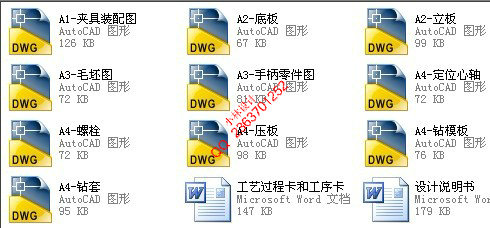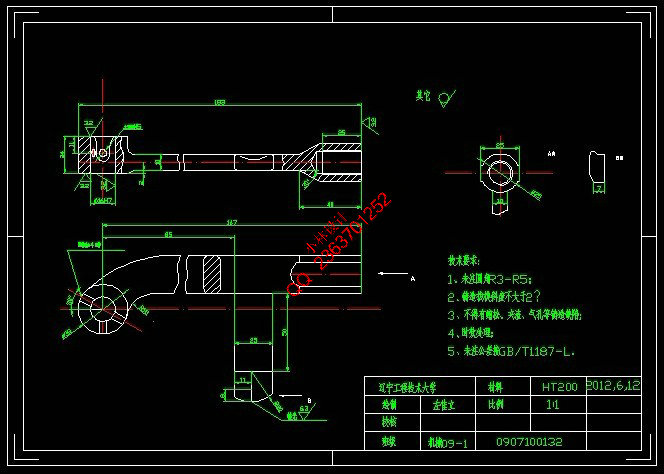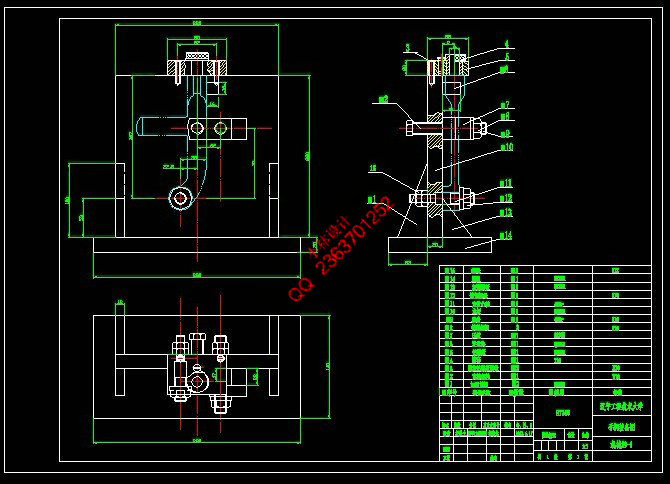|
设计描述:
文档包括:
word说明书一份,共16页,约6000字
CAD版本图纸,共10张
工序卡一套
过程卡一套
一、设计题目
C1318自动车床手柄M16孔设计
二、原始资料
(1) 被加工零件的零件图(草图) 1张
(2) 生产类型: 5000件/年
三、上交材料
(1) 被加工工件的零件图 1张
(2) 毛坯图 1张
(3) 机械加工工艺过程综合卡片 1张
(4) 与所设计夹具对应那道工序的工序卡片 1张
(4) 夹具装配图 1张
(5) 夹具体零件图 1张
(6) 课程设计说明书(5000字左右) 1份
四、进度安排(参考)
(1) 熟悉零件,画零件图 2天
(2) 选择工艺方案,确定工艺路线,填写工艺过程综合卡片 5天
(3) 工艺装备设计(画夹具装配图及夹具体图) 9天
(4) 编写说明书 3天
(5) 准备及答辩 2天
摘 要
此次课程设计是学习完《机械制造技术基础》这一门课程后的一次实践学习。所以,他最突出的特点是很强的实践性。在设计过程中,主要完成了某零件的工艺卡片与工序卡片的制定,进一步熟悉了机械生产的全过程;同时针对某一指定工序设计夹具体,实现零件的大批量生产。
此次课程设计的主要意义有:
一. 进一步熟悉所学课程,并应用到实践,再从实践中反过来加强对所学知识的熟悉程度。
二. 增强知识的综合运用的能力。此次课程设计,不但设计到《机械制造技术基础》这一门课程,更是对《机械精度设计与检测》、《机械图学》与《机械设计》等课程的一次全面复习,与综合运用能力的锻炼。
三. 增强自主解决问题的能力与设计能力。
Abstract
The curriculum design is another learning after the learning of "Manufacturing Technology" course this time. Therefore, his most prominent feature is the strong practicalism. We have completed the main parts of the process of a card and the process of a development of the card, becoming more familiar with the machinery of the entire process of production; At the same time for a specific folder we design processes and achieve high-volume production parts.
The main significance of the curriculum design has the followings:
First. To further familiarize themselves with the course, and applied to practice, from practice, in turn, enhance the knowledge of the degree of familiarity with
Second. The curriculum design is not only a totally review of the such courses as "Machinery Manufacturing Technology"、"precision mechanical design and testing"、
"mechanical Graphics" and "mechanical design",but also a exercise comprehensive use of ability.
Third. Enhance the ability of independent problem-solving and design capability
序言••••••••••••••••••••••••••••••••••••••••••••••••••5
一、零件的主要技术条件分析 •••••••••••••••••••••••••••••••6
二、选择毛坯、确定毛坯尺寸••••••••••••••••••••••••••••• 6
2.1 零件的生产类型 •••••••••••••••••••••••••••••••••••6
2.2 选择毛坯 •••••••••••••••••••••••••••••••••••••••••7
2.3 确定机械加工余量 •••••••••••••••••••••••••••••••••••7
2.4 确定毛坯尺寸 ••••••••••••••••••••••••••••••••••••••••7
2.5确定毛坯尺寸公差 ••••••••••••••••••••••••••••••••••••7
三、选择加工方法、制定工艺路线 ••••••••••••••••••••••••8
3.1 定位基准的选择•••••••••••••••• •••••••••••••••••••••8
3.2 零件表面加工方法的选择••••••••••••••••••••••••••••• 8
3.3 制定工艺路线 ••••••••••••••••••••••••••••••••••••••9
四、工序设计 ••••••••••••••••••••••••••••••••••••••••••9
4.1 选择加工设备与工艺装备 ••••••••••••••••••••••••••••••9
4.2 确定工序尺寸••••••••••••••••••••••••••••••••••••• 9
五、确定切削用量••••••••••••••••••••••••••••••••••• 10
5.1工序Ⅳ:切屑用量定•••••••••••••••••••••••••••••••••••10
5.2工序Ⅴ:切屑用量的定•••••••••••••••••••••••••••••••••11
5.3确定切削用量及基本工时••••••••••••••••••••••••••••11
5.4夹具设计及操作的简要明•••••••••••••••••••••••••••••••12
5.5.定位误析••••••••••••••••••••••••••••••••••••••••••12
总结•••••••••••••••••••••••••••••••••••••••••••••••••••••13
参考文献•••••••••••••••••••••••••••••••••••••••••••••••••14
| 







